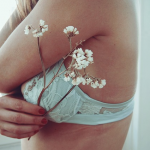For many future brides, the wedding dress is a symbol of love, tradition and femininity. Often during the first visit to the wedding salon you may have a problem with the choice of style, let alone the material. Satin dresses are simple and elegant, and lace are timeless and romantic. The same style may look completely different depending on the material selected. Therefore, try on both satin and lace evening dresses .
Features and benefits of lace

Lace is a delicate material. It is made of threads or yarns in a net-based pattern. It can be created manually or using threads. At the beginning, silver, gold, silk or linen threads were used. Currently, the lace is made of high quality cotton thread. However, silk and linen threads are still popular. You can also find lace made of synthetic threads.
We can find elastic and inelastic lace. As for the elastic lace, it contains some spandex with lots of nylon. In contrast, the inelastic lace is made of nylon only. You can also find varieties mixed with nylon, cotton or polyester.
The most characteristic feature of this fabric is embroidery. It looks special and beautiful. Most brides love lace dresses. They have a unique pattern and are a symbol of luxury. That is why it became number one. The main advantage of lace is lightness and transparency.
Features and benefits of satin
Satin is shiny and shiny. It is distinguished by a special weave of the material. For weaving satin, silk, cotton and wool are used, as well as synthetic materials, e.g. polyester or acetate, which reduce the cost of the fabric. Such a dress is very elegant.
Alencon lace
Is one of the most common types of lace used in wedding dresses. It is also sometimes called royal lace. Its name comes from the city where it comes from. Alencon lace has a long history. They were sewn for the first time in the 16th century in the French city of Alencon. This is a needle lace. The strands resemble thin strings. They are often decorated with crystals, pearls or sequins. They are still very popular due to their finesse and unique qualities.
Brussels lace
Brussels lace is very old-fashioned. If you love tradition, you’ll love it. A wedding dress made of this type of lace was first sewn in the 15th century in Brussels. This city in Belgium is known worldwide for lace. Initially, this term only referred to lace sewn in Brussels. However, now it is called bobbin lace. Brussels lace is extremely delicate. They are sometimes used for sewing details. They are distinguished by an unusual design. The floral details are created separately and then woven together to create a coherent whole. The design is unusual and attractive. There is no specific cordonnet in the background, as with other types of lace. Instead, there are open stitches bordering the pattern.
Chantilly lace
They are one of the most popular lace used in sewing wedding dresses. They have a delicate, smooth, mesh background. It is a kind of handmade lace and contain delicate details. That’s why she is extremely cute. It has a well-defined and clearly outlined pattern.
Chantilly lace was originally made of silk. Lace dresses were very delicate then. Modern versions are also woven from linen. They are distinguished by an amazing effect of light and shadow. It is unique for these laces. They are usually rich in floral details and motifs decorating the lace. Chantilly lace was chosen by royal families in ancient times.
Duchesse lace
They are various Brussels lace. Has more open space than other types of lace. She was named after Marie Henriette, Duchess of Brabant. Like Brussels lace, Duchesse lace also has large and exquisite floral motifs. However, there is a big difference between these two types of lace. In Duchesse lace, floral motifs are joined together using grids, not grid patterns. The lace motifs are raised from the base layer and contain mainly large areas of floral patterns.
Lace guipure
A characteristic difference is the lack of a grid. Most lace for wedding dresses is created on a net, while lace guipure has an open design. They are heavier than most types of lace. Is a favorite material for winter wedding dresses. Has an elevated texture and looks bold. Different motifs are connected using grids or braids instead of nets.
Schiffli lace
A light machine lace is used for overlays or edging. There is no mesh background, because after the lace pattern is embroidered, the mesh is dissolved by heat treatment. It is created on a machine or looms with an overlapping embroidery field. Details are created by meshing the tissue thread. This is not a traditional lace, because it is made of cotton fabric, not mesh. Although it is not a real lace, it is a popular finish with vintage edges. It is made of strong, stretch fabric. It is delicate and boho style.





